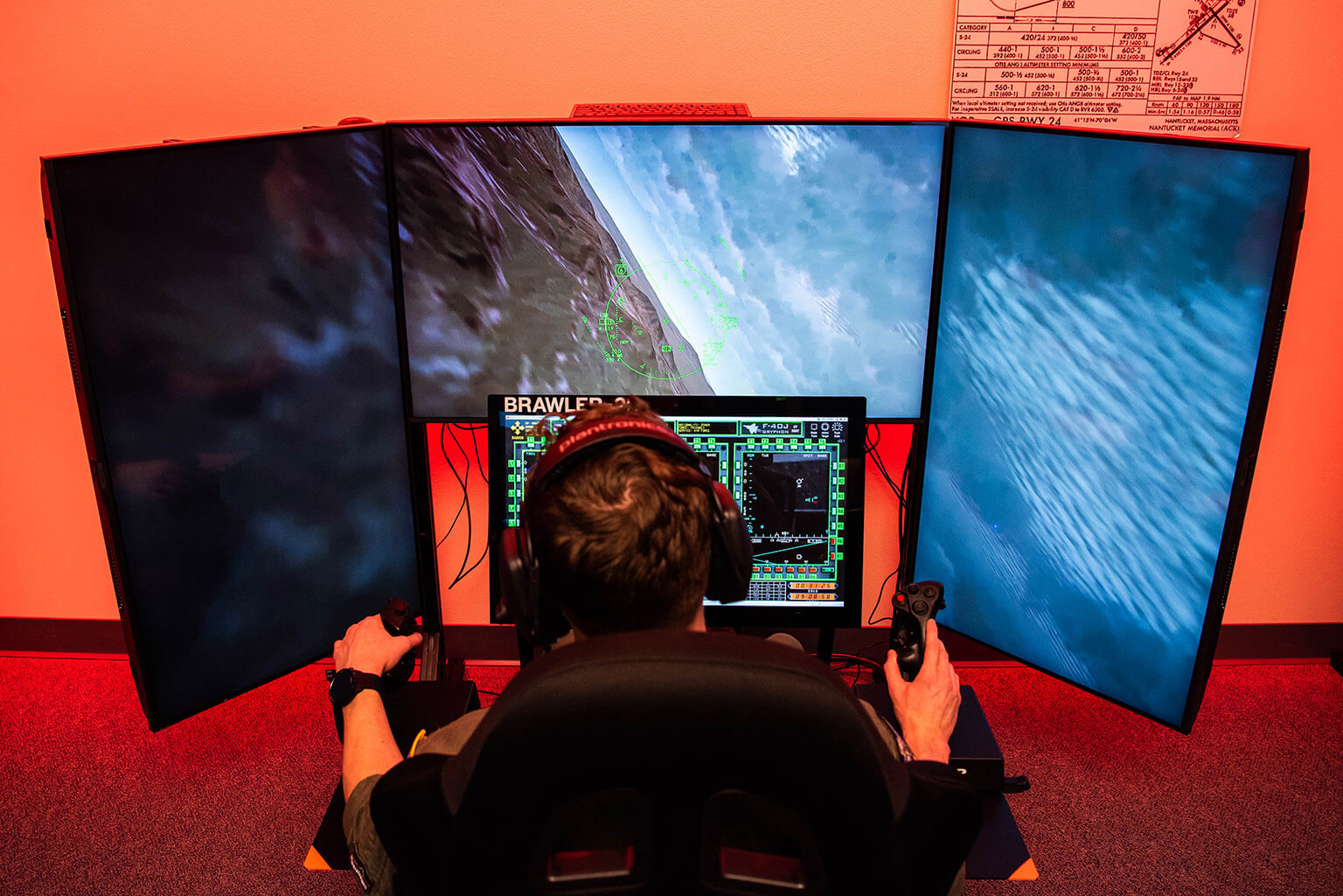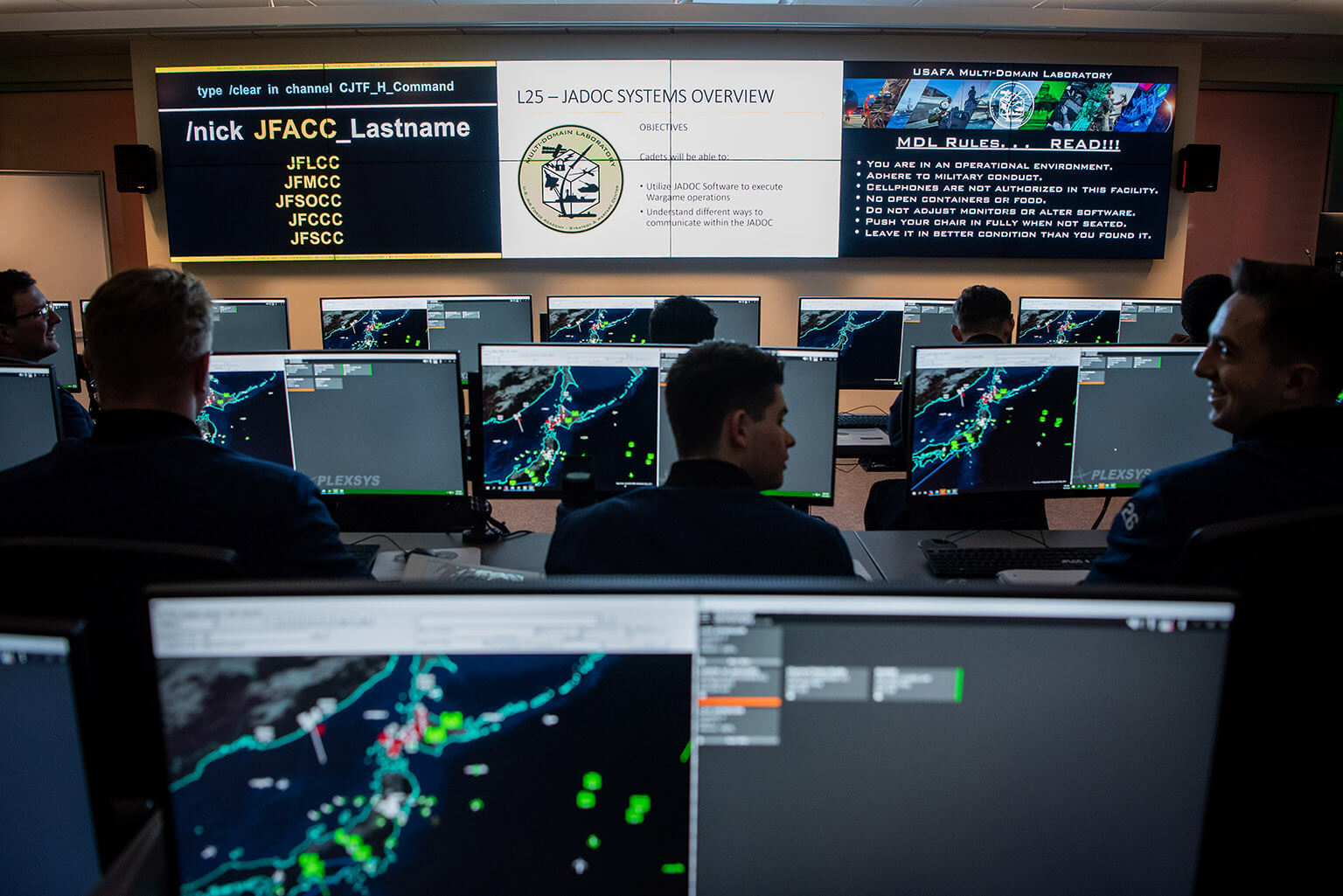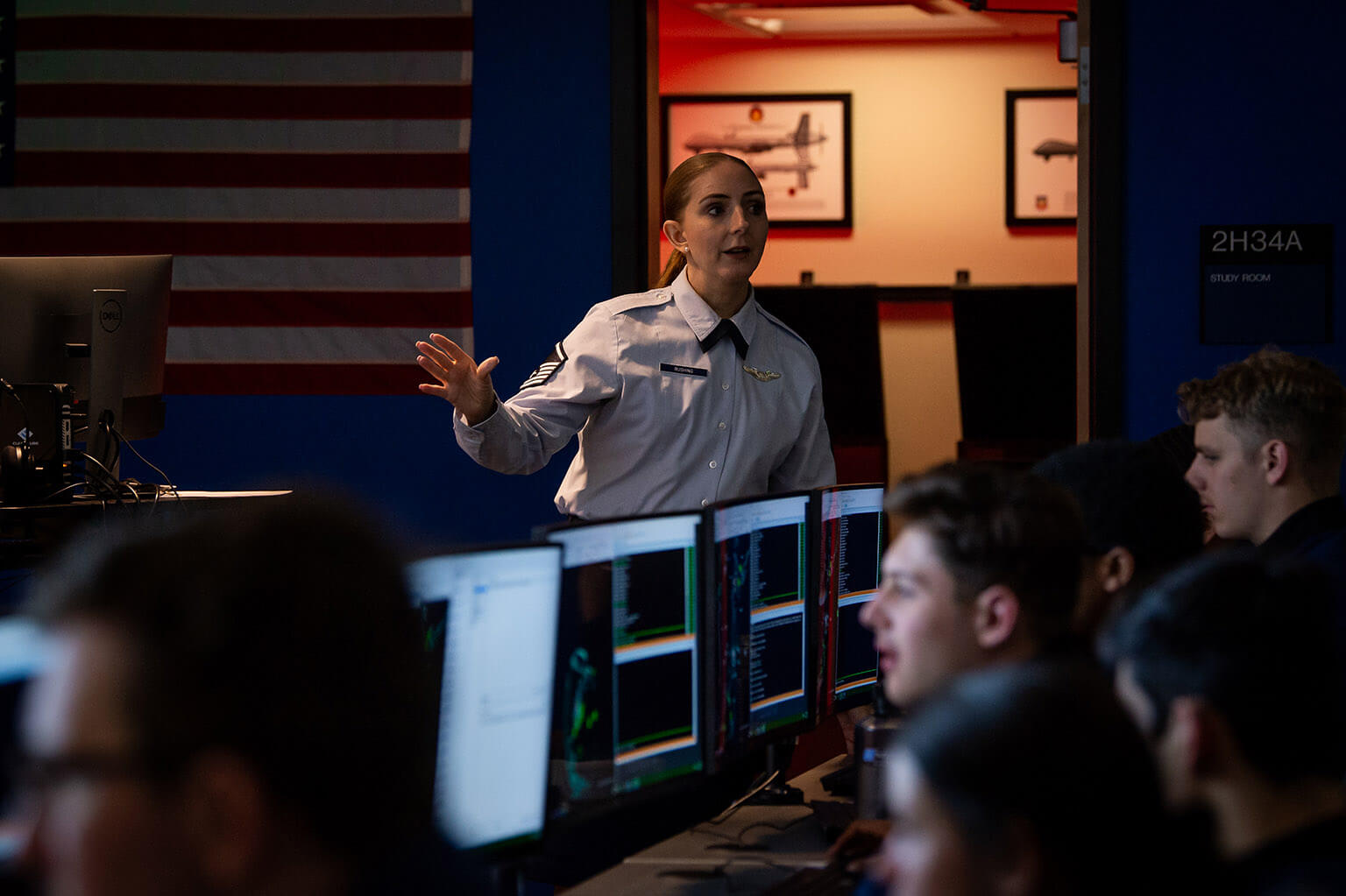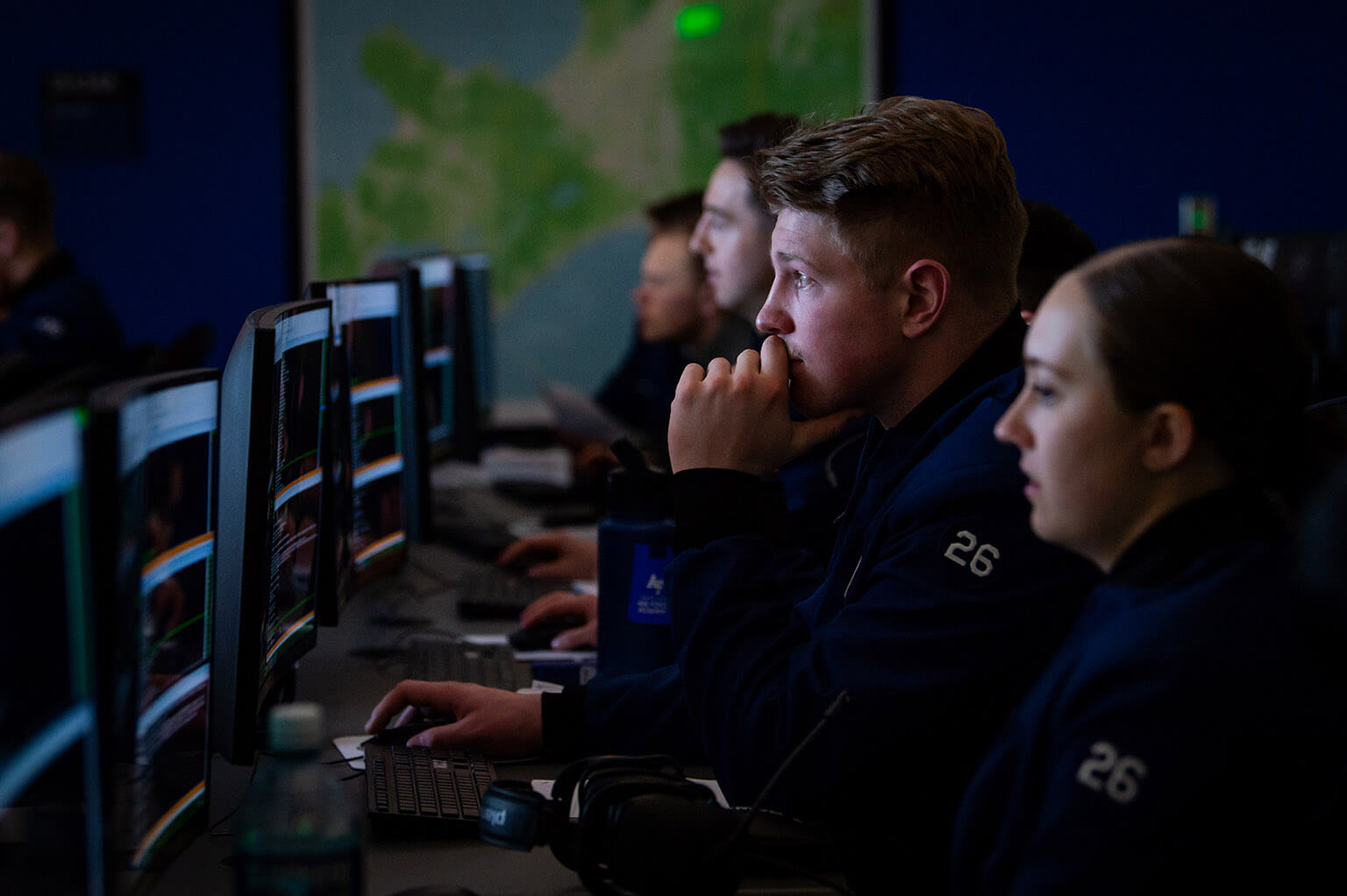Multi-Domain Lab offers realistic view of war operations
 The U.S. Air Force Academy Multi-Domain Laboratory’s educational flight simulators allow cadets to view real-time virtual terrain through aircraft window and radar views. (U.S. Air Force photo by Trevor Cokley)
The U.S. Air Force Academy Multi-Domain Laboratory’s educational flight simulators allow cadets to view real-time virtual terrain through aircraft window and radar views. (U.S. Air Force photo by Trevor Cokley)
By Randy Roughton
U.S. Air Force Academy Strategic Communications
U.S. AIR FORCE ACADEMY, Colo.– The U.S. Air Force Academy Multi-Domain Laboratory prepares future U.S. Air Force and U.S. Space Force officers by giving our cadets a clear and accurate view of battle operations.
The Multi-Domain Lab is the first and only lab of its type at any U.S. service academy. Although there are many war gaming and flight simulator facilities across the Department of Defense, the lab is the only place where multiple participant perspectives are linked together at a high-fidelity, unclassified, educational level of learning, said Maj. Nicholas Rayl, Academy Military & Strategy Studies Multi-Domain Lab instructor.
Taking learning from the classroom to the lab
“The Multi-Domain Lab takes the concepts out of the textbook and gives the cadets a way to experience them in all environments–auditory, visual and tactile,” Rayl said. “It introduces cadets to war-fighting concepts and fundamentals far earlier in their career than they would otherwise. Rather than waiting until they are majors and lieutenant colonels to get into these concepts, we are introducing them much earlier in their careers, which should have a long-term effect.”
 U.S. Air Force Academy cadets learn through fictional operational scenarios in the Multi-Domain Laboratory. Master Sgt. Bonnie Rushing and the Multi-Domain Lab staff filmed and produced customized fictional media broadcasts for the lab’s wargame scenario. These communications include US and allied media and broadcasts from fictional adversaries.(U.S. Air Force photo by Justin Pacheco)
U.S. Air Force Academy cadets learn through fictional operational scenarios in the Multi-Domain Laboratory. Master Sgt. Bonnie Rushing and the Multi-Domain Lab staff filmed and produced customized fictional media broadcasts for the lab’s wargame scenario. These communications include US and allied media and broadcasts from fictional adversaries.(U.S. Air Force photo by Justin Pacheco)
Training on the educational flight simulator
The 7,000-square-foot facility contains two flight bays filled with 24 educational flight simulators that can replicate any real or imagined air, space, surface or sub-surface weapon system. Cadets learn by flying simulated missions in the lab’s educational simulators in multi-domain battle scenarios as part of the core Airpower and Joint Operations Strategy Course.
“If you’re invested in it, [the Multi-Domain Lab] will become the highlight of your day when you’re flying a simulated B-1 Bomber or F-18 Super Hornet or anything like it,” said Cadet 2nd Class Liam Thomas Champagne. “You’re experiencing it in real time. The Multi-Domain Lab gives me an idea of how to prepare if I want to be a pilot, an intel officer, or an air battle manager. It gives me insight on what I’m going to see in my future career.”
“For example, they practice hands-on flying while learning the importance of logistics, and another day they simulate operations in a different mission, learning how bombing missions have changed since World War II,” said Master Sgt. Bonnie Rushing, Military and Strategic Studies Department Senior Enlisted Leader and course director. “They then draw connections from the flight bay experiences to the classroom and the wargame in the lab’s operations center.”
 Master Sgt. Bonnie Rushing, Military and Strategic Studies Department senior enlisted leader and course director, teaches cadets in the U.S. Air Force Academy Multi-Domain Laboratory. Cadets now learn, using the lab’s educational simulators in multi-domain battle scenarios as part of the Airpower and Joint Operations Strategy Course. (U.S. Air Force photo by Justin Pacheco)
Master Sgt. Bonnie Rushing, Military and Strategic Studies Department senior enlisted leader and course director, teaches cadets in the U.S. Air Force Academy Multi-Domain Laboratory. Cadets now learn, using the lab’s educational simulators in multi-domain battle scenarios as part of the Airpower and Joint Operations Strategy Course. (U.S. Air Force photo by Justin Pacheco)
Learning for all warfare levels
The lab also includes 12 remotely piloted simulators, 12 intelligence, surveillance and reconnaissance electronic warfare simulators, and 40 operations command center workstations. The simulators can be configured for learning across all strategic, operational and tactical levels of war.
In the remotely piloted aircraft room, cadets can simulate full-motion video and understand how to operate a mission and integrate them into different levels of operations, Rayl said.
The facility is completely air-gapped, meaning it is not connected to any outside network. Cadets face scenarios that are not connected to real-world events, though the situations might resemble what they may face in their careers as Airmen or Guardians. All media, both pro-U.S. and pro-China and pro-Russia, is custom-built for the lab.
Continuously working to make the lab even better
The Multi-Domain Laboratory staff is continuously working on ways to improve the experience for cadets. This year, instructors are trying to add more space capability. They also look for ways to incorporate artificial intelligence into the lab and try to connect with the other service academies to convert the lab into “a fully Joint-simulated space,” Rayl said.
“I would say this lab is the embodiment of the idea that at the Air Force Academy, we value and promote hands-on experiential learning,” Rayl said. “You can learn from a textbook anywhere but being able to have these types of hands-on experiences is unique to the Academy.”
 The U.S. Air Force Academy Multi-Domain Laboratory can be configured for cadet learning across all strategic, operational and tactical levels of war. Cadets train in multi-domain battle scenarios as part of the Academy’s core Airpower and Joint Operations Course. (U.S. Air Force photo by Justin Pacheco)
The U.S. Air Force Academy Multi-Domain Laboratory can be configured for cadet learning across all strategic, operational and tactical levels of war. Cadets train in multi-domain battle scenarios as part of the Academy’s core Airpower and Joint Operations Course. (U.S. Air Force photo by Justin Pacheco)
For more photos of the Multi-Domain Lab, see Flickr.